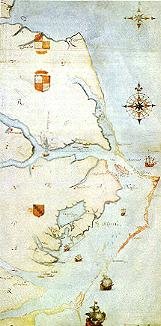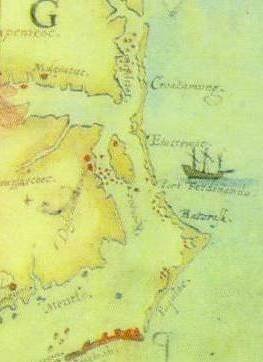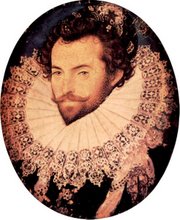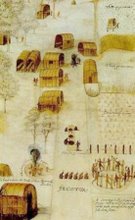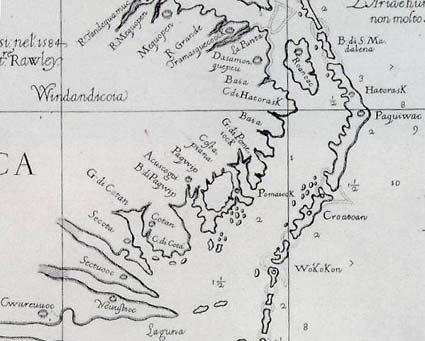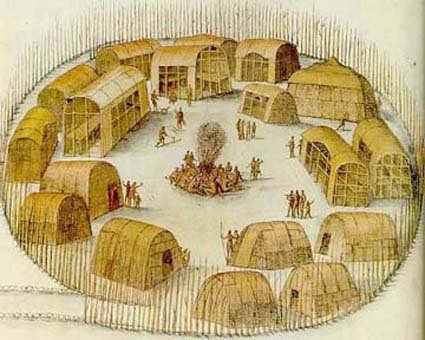
Since most of our cast of players in the drama that fascinates and drives our research into the Lost Colony, came from London and other parts of England, it is interesting to think about the customs of the world they left behind.
And whereas most of us are finished with Christmas 2009, the Elizabethans were just getting started with their celebrations which culminated on the 12th Day of Christmas. The wealthier people and certainly the Royal Court had huge banquets and entertainments every night during this time. Our major players had probably attended such events the year before they left for the colony.
What a contrast between that year and the year which followed after their virtual abandonment in the New World. No Court entertainments or stuffed peacocks there. Only hunger and dispair unless some Indian tribe took them in and fed them. And would this have happened in the midst of a terrible drought?
Elizabethan Christmas
An Elizabethan Christmas is something that we today would recognise on the whole, of course some of the traditions varied from ours but they are very similar on balance.
Turkey is a popular meat at Christmas and despite it being introduced to England earlier in the centuary, during an Elizabethan Christmas you would have eaten Duck or Goose for your Christmas meal, both common birds to England, fortunately for Turkeys, it was to be sometime before they had a reason to panic at the onset of winter!
For the Elizabethan Christmas dinner of 1588 everyone was ordered to eat Goose for the Christmas meal by Queen Elizabeth, as a celebration of the recent victory over the Spaniards and their armada.
As we stated in an earlier article on this site,(Elizabethan diet) Peacocks were considered food too and they would often be skinned and roasted then the cooked bird would have its skin, feathers and all, placed back over it. Obviously Peacocks were expensive so this limited the practice.
Another firm favourite for the Elizabethan Christmas meal was wild boar, im sure you have seen films where the boars head is cooked and put on a platter in the middle of a table, this is historically accurate and actually happened, the meat from the head was consumed during the Christmas meal but not yet.
Elizabethan Christmas’s wouldn’t be complete, like today’s, without a Christmas pudding whereas ours are of a sweet confection with raisins and plums within the Elizabethans wasn’t.
A Christmas pudding then was made of meat and spices with a filling ingredient of Oatmeal, to keep it all together the mixture was cooked within the gut of the poor unfortunate Boar we met earlier.
This would then be served with pieces of meat from the Boars head which was on display.
The Elizabethans introduced Brussels Sprouts into the Christmas in the late 1580’s and they have been dreaded ever since.
http://www.seatofmars.com/elizabethanchristmas.htmAn Elizabethan Christmas Feast: Sugar, Spice and All Things Nice
by Marta Patiño
Christmas in 16th century England is best illustrated by the old adage: 'eat, drink and be merry'. England didn't have much cause for celebration during the dark years of Mary Tudor's reign, which saw 300 people burnt at the stake for heresy, so the young Elizabeth's rise to the throne was a welcome change. The enigmatic queen swept away the stale solemnity of Mary's court, replacing it with an appreciation for luxury, extravagance and popular culture.
The Christmas feast was the highlight of the year for those households that could afford it and no expense was spared. A popular main dish was Brawn and mustard, made from force-fed boar meat. Other traditional meats served included roast beef, goose and turkey.
Turkey was first introduced to Europe from the Americas during Henry VIII's reign and gradually rose in popularity as a Christmas dish, given that it was cheap and quick to fatten. For the well-to-do, the most traditional meat eaten on Christmas Day was goose. It is said that in 1588 Elizabeth I ordered the entire country to serve goose at their Christmas feast, since it was the first meal she had eaten following England's victory over the Spanish Armada and would thus provide a fitting tribute to the Navy Royal. Christmas was a singular occasion and each household would have spent as much as possible on their Christmas feast. That said, many households wouldn't have been able to comply with the Queen's demand, since goose was at that time an expensive luxury.
The main meat dishes were accompanied by plum porridge, minced pies and a beer brewed specially for the occasion. During the Elizabethan age water could carry disease and was not considered fit to drink. Instead, beer was the staple drink for the majority of people at all levels of society and it was common for country homes to house their own brewery. Beer was also sold at tap houses and taverns, which did a rollicking trade during the 12 days of Christmas.
Banqueting tables at grand homes were decked with spectacular fare for the Christmas feast, affording the nobility an ideal opportunity to flaunt their wealth and creativity. Roasted swans and peacocks provided a dramatic centrepiece for affluent tables. These elegant birds were placed at the centre of the table, their feathers still in place despite the birds having been thoroughly cooked. The trick was to skin them for the roasting process before slipping them back in their skins. Wealthy households also liked to serve wild boar, the animal's head providing yet another spectacular table decoration.
© History Chasers
Click here to view all recent Searching for the Lost Colony DNA Blog posts





